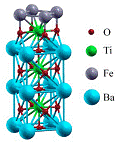Department of Physics and Astronomy: Publications and Other Research

Evgeny Tsymbal Publications
ORCID IDs
Yang http://orcid.org/0000-0002-3235-1986
Tao http://orcid.org/0000-0001-6003-100X
Tsymbal http://orcid.org/0000-0002-6728-5480
Document Type
Article
Date of this Version
2021
Citation
npj Computational Materials (2021) 7: 204
doi: 10.1038/s41524-021-00679-2
Supplemental materials are available at https://doi.org/10.1038/s41524-021-00679-2
Abstract
Multiferroic materials composed of ferromagnetic and ferroelectric components are interesting for technological applications due to sizable magnetoelectric coupling allowing the control of magnetic properties by electric fields. Due to being compatible with the silicon-based technology, HfO2-based ferroelectrics could serve as a promising component in the composite multiferroics. Recently, a strong charge-mediated magnetoelectric coupling has been predicted for a Ni/HfO2 multiferroic heterostructure. Here, using density functional theory calculations, we systematically study the effects of the interfacial oxygen stoichiometry relevant to experiments on the magnetoelectric effect at the Ni/HfO2 interface. We demonstrate that the magnetoelectric effect is very sensitive to the interface stoichiometry and is reversed if an oxidized Ni monolayer is formed at the interface. The reversal of the magnetoelectric effect is driven by a strong Ni−O bonding producing exchange-split polarization-sensitive antibonding states at the Fermi energy. We argue that the predicted reversal of the magnetoelectric effect is typical for other 3d ferromagnetic metals, such as Co and Fe, where the metal-oxide antibonding states have an opposite spin polarization compared to that in the pristine ferromagnetic metals. Our results provide an important insight into the mechanism of the interfacial magnetoelectric coupling, which is essential for the physics and application of multiferroic heterostructures.


Comments
Copyright 2021, the authors. Open access
License: CC BY 4.0 International
Published in partnership with the Shanghai Institute of Ceramics of the Chinese Academy of Sciences